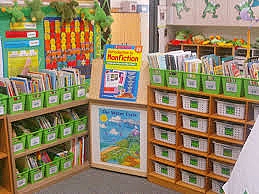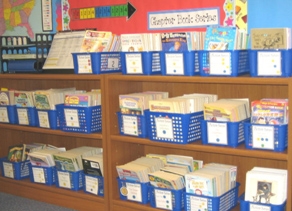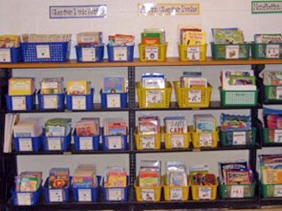The classroom library is an important resource for a Balanced Literacy classroom. Studies show that in classrooms with accessible, well-organized libraries students read up to 60% more and engage in more than twice as many literacy related activities. So, what makes a strong classroom library? The answer to that question has two parts. One, is how can I set up the structure and content of my classroom library. Two, is how can the classroom library support my teaching and the students’ learning? This Blog will focus on the first part and the next Blog will discuss the second.
How can I set up the structure and content of my classroom library?
Many teachers have limited space in their classrooms. Finding an area that can house the collection together can be a challenge. Find a centrally located place that demonstrates the value of this important resource. Using whatever shelving, display, and storage resources available, set up the library so that students can see the texts and types of texts easily. Be sure to keep the texts together in one area, so that students can self-select quickly and efficiently.

Books: How many books do I need to have?
Fountas & Pinnel recommend a minimum of 1-12 texts per student or a range of 300-600 texts, depending on the levels of your readers and the number of multiple copies. Early readers in primary grades tend to read 100-125 books during a year, while students reading above the second or third grade level read 50-75 books a year. We want students to independently read self-selected for up to 30 minutes every day, so we also need to consider how many texts we are requiring to be in each student’s book bin. In a preschool or kindergarten setting, where we may divide those 30 minutes into smaller segments, we want to be sure students have enough books to read, review, and look at pictures so that they are engaged for that amount of time. For an early emergent reader to be engaged for 15 minutes, they need 15 books. If you have 20 students, you may deplete your book collection if you only have 300 books. So, early learning and primary teachers need to consider having closer to 600 texts.
Text Types: What types of books do I need to have?
Our students need to read a balance of literary fiction, narrative nonfiction, and informational texts. Literary fiction includes many genres. Informational texts have at least seven different structures. Students need to have access to both.
Image text complexity measurement As we consider the expectations of the common core and the goal to have students read complex texts, many teachers focus too closely on Lexile ranges. However, the CCSS reminds us to view complexity from three lenses; 1) the quantitative aspect, which is Lexile; 2) the qualitative, which considers the purpose, meaning, structure, and language the author uses and the knowledge she expects from the readers; and 3) who the reader is and what the reader is supposed to do with the text experience.
It is important that we do not organize our classroom libraries by Lexile, as this is an incomplete way to organize your resources. You may wish to have a section of texts organized by Lexile to support students as they develop self-selection strategies, but we also need to have bins and sections organized by genre, text structures, content area topics, and classroom interest areas such as favorite authors and series books.
Organization: Are there guidelines for organization and accessibility?
Engaging and accessible classroom libraries are organized to support student self-selection and to interest and engage them to read a wide variety of texts. Students need to know their reading range, the genres they can be reading, and the different types of informational texts they need to learn about and be able to find these texts along with the texts that meet their interests. Bins or shelves organized and labeled by genres, text types, and level range, with pictures can best support easy selection and return.


This article is #5 in the twelve-part series, “Getting My Classroom Ready for Balanced Literacy Instruction: Classroom Culture and Environment.”